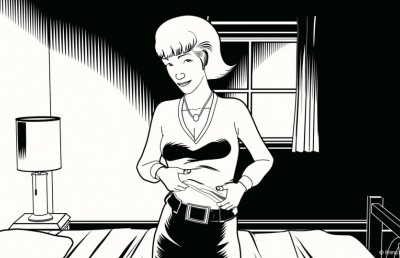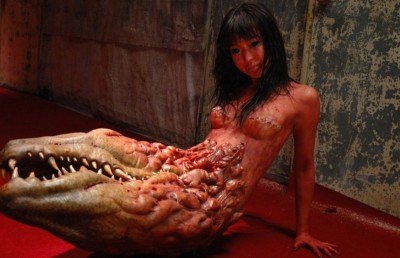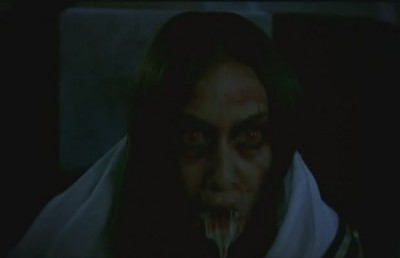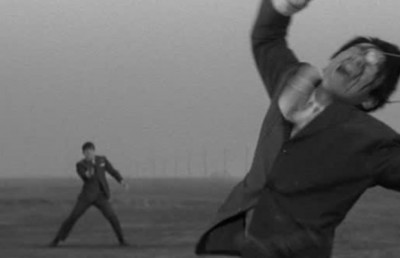Frank Henenlotter: From Basket Case to Bad Biology
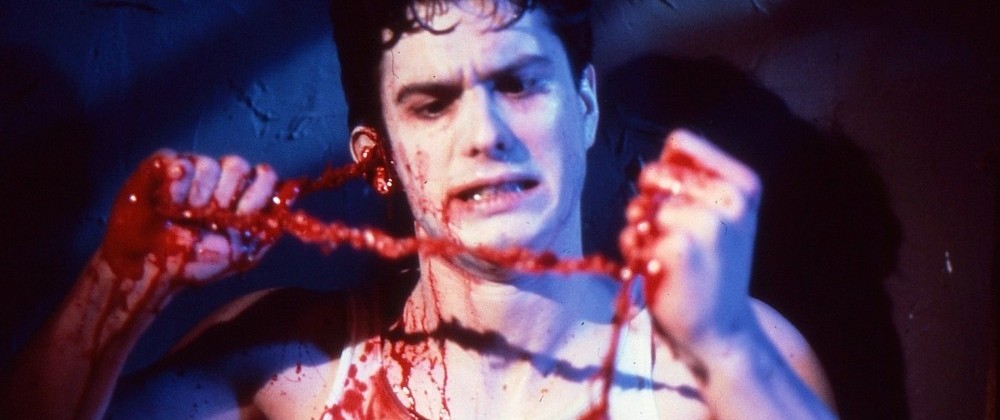
There are not that many directors who could be considered exploitation auteurs, but the name Frank Henenlotter would be at the top of any such list. Although his films (Basket Case (1982), Brain Damage (1988), Basket Case 2 (1990), Frankenhooker (1990), Basket Case 3: The Progeny (1992), and Bad Biology) have been discussed as horror and cult films, Henenlotter prefers to think of them simply as good old fashioned exploitation fare, in the tradition of earlier exploitation gurus Herschell G. Lewis, David Freidman, Kroger Babb, and Harry Novak. Henenlotter was invited to present his first feature film in sixteen years, Bad Biology, at the 2008 Fantasia International Film Festival in Montreal. With Bad Biology it feels like Henenlotter has never been away and the film doesn’t miss a beat in bringing us back to the grindhouse days of the late 1970s and early 1980s that Henenlotter dearly misses. The film is brazen, funny, sexy, violent, and, yes, exploitative. The film features two young leads saddled with their own physical/sexual mutations that put them both in sexual overdrive. The two characters are kept separate in the narrative structure until they collide in the film’s final third. The first character we meet is the attractive Jennifer (Charlee Danielson), a photographer with seven citori (or is that clitorises?) in her vagina alone, which produces a monster size libido. Unfortunately, she gets so excited during intercourse that most of her mates don’t survive the experience. Her unknown soul mate is Batz (Anthony Sneed), a lonely hearts type with a monster of his own –his penis– which he keeps satisfied with a steady diet of porn, masturbation, and injections of steroid. When Jennifer learns of the size and voracious appetite of Batz’s penis she is determined to meet him and achieve the ultimate copulation. Things get complicated when Batz’s penis makes good on the pun, “it’s got a head of its own,” by leaving Batz’s body for a sexual spree. The affable Henenlotter graciously gave of his time for this in-depth interview about his early career and his recent film.
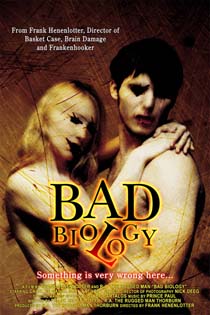
Offscreen: There is a sixteen year gap between Bad Biology and Basket Case 3: The Progeny (1992). Did you miss making movies?
Frank Henenlotter: I miss making movies when I came up with a great idea of something I wanted to do. I did not miss the physical aspect of making a movie, because that is really hard work and misery, especially when you don’t really want to make the movie. And I did not want to make Basket Case 3, even though I had a wonderful time with the actors and the crew. After that every time I would try to get a picture going I was told no, no it is not mainstream enough. Or, no no, no it is too crazy, or no no no it is too dirty, or it is too violent. All I kept hearing is, “What about Basket Case 4, we’ll take that. It was so dispiriting and at the time in the early ’90s the marketplace drastically changed. That is when we lost most of the theaters in the U.S., when we lost most of the video companies in the U.S., the early ’90s. Suddenly everyone I knew who is in the business no longer had a business, and naturally when the market shrinks Hollywood takes over, the major companies, and everything becomes homogenized, everything becomes mainstream, and the exploitation movies, which is what I think I make, I do not make horror movies, suddenly the exploitation movies are not being shown or made because those companies were gone. And in fact 42nd street was gone. So it was not really a time for me to keep banging my head against the wall. The films I wanted to make no one wanted to finance and the kind of films they wanted me to make I was not interested in.
Offscreen: So this obviously leads to the very important work you did with Something Weird Video, the researching and archiving of rare films.
FH: That just happened, floated to me. It was not a cause and effect thing. I did not say, “if I cannot do this then I will do that. It would have happened anyway. In fact if I continued to make films I still would have worked for Something Weird video. Probably not as intimately and deeply as it became, which was always behind the scenes because I was never interested in being upfront. It is not my company and in fact if you go back and look at any of our catalogs you’ll see a whole bunch of writers, probably two of those names were real and the rest was all me. I just found it easier to right under a whole bunch of phony names. That was very fulfilling work, finding the negatives, and restoring them. Mike [Varney, owner of Something Weird] and I would just howl at how we were restoring these films that everyone else would rather have stayed lost. But it is a huge chunk of Americana that is ignored and that nobody cared about, and whether or not the films are worth anything or not, and most of them are not, but the fact that they exist is what makes them worth it. That’s the story, not that this film is called In Hot Blood (Joel Landwehr, 1968), but that a film like In Hot Blood actually played in motion picture theaters, and people paid money.
Offscreen: And of course you also did Mondo movies and not just exclusively American movies.
FH: Oh yes. We dealt with American versions of stuff. We had to be very careful about which films were unlicensed and that we were not stepping on people’s copyrights. As a side effect I became something of a copyright expert. For years I had run the copyright checks and I had not screwed up once. There were many times when we would get a threatening letter, something that sounds like we were in deep trouble, and I would no my check again and say, “you tell them, produce the paperwork or shut up.” So far I have a clean record.
Offscreen: Of all those films is there one that you are particularly proud about saving?
FH: Actually many. Confessions of a Psycho Cat (Herb Stanley, 1968), because its starred Jake LaMotta, something not mentioned in Raging Bull! Dreck like, House on Bare Mountain (Lee Frost, West Bishop, uncredited 1963), which was the first film that had naked women and monsters. Absolutely awful, but there is a charm about its awfulness. You’re talking about films that were so marginalized, they were not made by filmmakers they were made by businessman….well, that is not entirely true, there were filmmakers who started there and grew out of it, but the majority. Like David Friedman, who was a great producer of this stuff and he wanted to make real movies. But for the most part it was guys who thought, I can invest $200, get some women to show their tits and make $400 out of it. There was no need for quality when all you need are a couple of women running around in their panties, and I happened to agree (laughter).
Offscreen: I remember watching second and third generation bootleg videotapes and now I find it so amazing that we can get these rare films in such great condition and transfers on DVD.
FH: Last night I went out with a couple of friends and we were talking about the birth of VHS, in the late 1970s. I remember not being interested in it at first because in the U.S. the first video company was called magnetic video, a guy named Andre Blay put it out, and he ended up producing Brain Damage for me. He licensed a bunch of titles from 20th Century Fox, and every thought he was crazy. They put these films out at a whopping cost like $89.95, and a lot of them were made from 16 mm prints, no quality, no proper aspect ratio. They had Sound of Music and films like that. I remember watching this and thinking I’m not interested. And then other companies started coming out and I remember one day walking into a video store to see if there was anything that I was missing yet, and I see Beyond the Valley of the Dolls (Russ Meyer, 1970). Even though it was from a 16 mm cropped prints, I needed to own it, and then I looked and I saw Blood Feast (1963, H.G. Lewis) and I thought, OK time to buy a recorder! I bought a machine the next day, one of those top loading Betamax with the big piano keys; and no remote, although some of them had the remotes with a cord. My first three movies I bought were Beyond the Valley of the Dolls, Blood Feast, and Apocalypse Now. I was so happy that I owned Apocalypse Now, even though the image was dark and murky and cropped. It was terribly compromised but I owned did. In fact a joke about it was that of those first three films, the one that looked best was Blood Feast, because it did not suffer from the transfer.
Offscreen: It was probably shot full frame I would think.
FH: Well, that is a good point. We released it at full frame, but I suspect when it was shown theatrical it was 1.85, but when we put a 1.85 matte on it we felt that it was is losing too much information so we released it full frame.
Offscreen: It is actually a nice transfer.
FH: Oh yes, it is from us [Something Weird] because only we have it. It was not a high-definition transfer, but for the time it was state-of-the-art digital. I actually spent a lot of money cleaning that one up. And it was a huge seller for us. If you are going to start a library about transgressive stuff that is the place to start.
Offscreen: You dedicated your first film to Herschell Gordon Lewis, right?
FH: Yes I did that is right. And not only that but I am finishing a documentary on him, through Something Weird. Jimmy Maslin, who owns the Lewis library, started a documentary a couple of years ago. I did not want to get involved in it at the beginning because I thought it was Maslin’s film and I just suggested a few things, but it stalled and then they asked me if I wanted to edit it, and again I was not sure. I saw the footage and I told them, “I do not want to edit this, but I would like to take it over, and Jimmy Maslin said, “please.” And of he is the biggest supporter of it right now.
Offscreen: Did you have to do any re-shoots?
FH: Well we are not doing reshoots but we are adding material because we had to go back and interview more people because they forgot to ask about a bunch of films, and I want to cover everyone of his movies. And I am having a great time doing it. We are just about finished it, and then I’m going to do another one. I did not approach it as a documentary. In fact, I did not realize until a couple weeks ago that I was actually making a documentary! And I love the format. So we have already started doing preliminary work on another documentary on the history of exploitation cinema. Well, actually, the history of nudity or the history of sexploitation cinema. Starting with 1920’s shorts like Secret of a Hollywood Extra. The minute hard-core enters the scene the nudie movie is over. And working with Something Weird video 80 percent of it is already shot. I just have to pull my favorite clips out of it. I know the shots in my head and they just crack me up. My favorite is from a film with the unbelievable title of Pussy Galore, despite the fact that there was no full frontal nudity. I think the nudist colony footage is of foreign origin, maybe French, but the highlight of the film for me is when these two totally bare assed women walk up to a slot machine in a nudist camp and begin to play it. Where were they carrying the change!!! Moments like that I just live for.
Offscreen: So obviously you miss the sordidness of 42nd Street theaters?
FH: Oh absolutely. From the time I was little kid growing up in a small town in Long Island I used to go to the movies myself and in those days they had children’s matinees so it was safe for the children to go to the movies alone because they would segregate the theatre by putting the children in one section and they did not allow adults in unless they were your mom or dad or guardian. So it was a more innocent time. I was seeing movies like The Tingler (William Castle, 1959) when I was nine years old and I was taking them seriously. I had no idea there was humor involved. And I saw it in the theatre with the gimmick seats and it did not occur to my nine-year-old brain to look under the seat, but when I saw adults, who to me must have been teenagers, jumping out of their seat it terrified me. I did not want my seat to buzz. And I remember leaving the theater just exhausted from fear….and what a great feeling it was, thinking I want more of this. We used to take class trips to go to the Museum of Natural History, The Museum of Modern Art, and one time our bus went down 42nd Street and I saw row after row of movie theaters. It did not occur to me because growing up in a town I just thought there would be one or two theaters per town. I could not believe it and could not wait to get back to see what that was all about. And from the time I was 15 I started cutting school and taking the train to Manhattan. It never occurred to me that it could be dangerous.
Offscreen: You would do this alone?
FH: Yes. At 15 years old back you’re still a naive puppy dog. It is not like today’s 15-year-olds. And I quickly learned that if you weren’t buying hookers, male hustlers, are drugs, they would leave you alone. All you had to do was shake your head no and you were left alone. So I never encountered problems. We would see fights in a theater, which to a child was cool and exciting, but I would try to cram in as many films as possible in a day. When I finally moved into Manhattan I was going to 42nd Street six nights of the week. And on Sunday they would start early in the morning and it was so cheap. You could see two or three movies and it would not hurt your pocketbook. Those theaters did not advertise in the newspapers. They basically attracted transients walking down the street and looking for a place to get out of the weather. When it was very hot or raining or snowing the theaters would be packed. And they would lure you in not only with poster art but with these displays that would be like archways built around the entrance to the theater filled with photos. They would take the most innocent type of photo and sex it up with red blood and words like ‘lurid,’ ‘shocking.’ I remember my favorite was ‘she’s sexy.’ I was so thrilled when Basket Case was playing there, and in plain sight on the marquee they wrote, “they’re Siamese twins!” And I thought, thanks for ruining my punch line! But it was marvelous and a great way of studying audiences responses to movies. As much as the people there were transients they loved movies. All you had to deliver to them was a little bit of blood and you would get an ovation. If you did symbolism or went arty they booed. If you showed money they cheered; guns they cheered; that is how I thought movies should be. And there was something communal about the response. And if the film stunk that also became fun. One of my most enjoyable times there was watching the Blackenstein (William A. Levey, 1973). I don’t think there were more than a dozen white guys like me in the theater and at first they were like “what the fuck,” and then they started laughing at the movie and started loving it. I miss that terribly.
Offscreen: What did you think of the Tarantino/Rodriguez Grindhouse double bill?
FH: I did not see it. I’m not interested. First of all why are you doing fake grindhouse for a couple million bucks? I don’t understand it. It is not real grindhouse. Reels were not messing. Everything that I’ve heard about seems wrong. Rather than seeing a fake grindhouse double bill I would rather sit down and watch the Corpse Grinders, the real deal.
Offscreen: I think a lot of purists have seen it that way.
FH: I did not I know what they’re trying to do, but I just thought it was a bad idea. Or not an idea that appealed to me.
Offscreen: It is like trying to make a camp movie, which you can’t do. It has to happen naturally.
FH: Exactly. Or, “We are going to make a cult movie today.” You have no say in it. Basket Case became a cult movie but that nothing to do with me. I was terribly embarrassed by that. I was horrified at the end result. One of the reasons why I did the movie was because I thought no one would really see it. I thought it would play on 42nd Street, no one would see it and my sins would never be uncovered. If I thought I was smart enough to make a cult movie I would have messed it up so much that it would be forgotten about.
Offscreen: Just to change gears a bit, there is this article I wrote in which you are discussed, the full title of it is, “Lionel, your mother made my dog: Peter Jackson and gore gag comedy.” People like yourself and Sam Raimi, Peter Jackson, Stewart Gordon, were making these really interesting films in the late ’80s and early ’90s. The whole point of my essay is that they weren’t only comedies, they were actually taking visual slapstick language from silent comedy, like Buster Keaton on acid.
FH: You know what else they did. We all did the same trick; the gore was so extreme that the question became, was it a comic punch line or a gory punch line? That was the beauty of it. People are still being ripped apart hideously and yet the people are laughing, that is the joke.
Offscreen: There’s also a structure to the way the gore was committed.
FH: In my case I actually developed it like I was doing comedy. You build to the punch and then a new punch line. In my case what I try to do is always keep the audience from knowing whether they are going to be shocked or laugh. Sometimes both. And sometimes one after the other and I like confusing things that way. Brain Damage starts off funny and it doesn’t end that way. Bad Biology is so tongue in cheek it is hard to tell if we were even aware that it was funny. I like that. Look at Peter Jackson’s Brain dead or Dead Alive. There are moments in there where you’re sitting there thinking, this cannot be a comedy. and yet you’re howling.
Offscreen: There is a quote from the same article and I’m quoting myself here, “Henenlotter expresses a unique and, for some, uneasy blend of social conscience and exploitation cinema in the three Basket Case films (treatment of physical deformity), Brain Damage (substance addiction) and Frankenhooker (a feminist twist on the Frankenstein story).” How do you react to that kind of statement?
FH: Well it is true. I am aware of that. Just because I making this stuff does not mean I have to make them dumb. And I like having something in there that gives you a little room for thought. And it happened by accident with Basket Case. When I was writing that I had nothing more intelligent in mind than that stupid monster that lives in a basket. I am writing description and it wasn’t working. And I’m thinking, of course it isn’t working, why would any human being walk around with a monster in a basket! So I’m having problems finishing this because it does not make sense. Then one day I’m in Nathan’s hot dogs in Times Square, which was then the biggest hot dog stand in Manhattan. It was such a large area that it is now where ABC has its TV station. And it hits me: he would carry it around if it were his brother. And once I hit on that it was, “well, look where I can go with that.” And that’s what made it a little bit more interesting. There was the same question with Brain Damage. He’s got a monster now on his body and I did the brother think: why else would he do it, because he has an addiction. And then when you think, drug addiction, it is just handed to you on a plate. And these are current themes so why not use them and play with them.
Offscreen: That is a consistency in most of your films, the theme of addiction. You said it well, and it also gives you an opportunity to go to the extreme of things because when you are drugged out you can do insane things.
FH: And I am back to that in Bad Biology, even though I felt like, gee am I repeating myself? It felt so right and I said, yes, but so what, I don’t care.
Offscreen: Although I did think it weird when the penis just left his body and went away, I thought, “what the heck, what happened here, is he imagining it.
FH: No it actually goes. Yes. You know a couple of times when we were approaching that I thought we should be a little bit more literal about what is happening, but every time I did it became a little ugly and the moment it became literal it lost the poetry of your penis getting up in the middle of the night and traveling out and having fun. And that is more of what interested me, the almost half-assed poetry of that. The more you try to make it realistic, then I have no film. How does a penis open a door?
Offscreen: We can move on to Bad Biology now. It was shot on 35mm?
FH: Yes.
Offscreen: But you don’t have a 35mm print?
FH: No, not yet. You are talking about maybe $40,000 just to have one or two prints made. Whereas if you have a good quality video projection, like we had here last night, where the picture quality looked better than if we had a 35mm print, certainly cleaner. The sound was messed up, but that is another story.
Offscreen: You mentioned last night that to save money you spent a few months prepping with the actors. Was that with just the two leads?
FH: No with everyone, but primarily the two leads for two months. I told everyone that when we are on location and the time is ticking I won’t have time to direct you. All I’ll have time for is to compose the shot and photograph it, so let’s work now. That is not entirely true but everyone came on the set prepared and then when there was an issue we would have time to work on it, like the ‘jimmy jigg’ scene. It was falling flat on the set and we stopped right away and said, what can we do to fix it, and let’s try this, this, this.
Offscreen: That was my favorite scene in the film, the addiction thing is right there.
FH: Yes, and without me ever showing drugs in the scene. There is no reference to drugs in the scene. Batz (Anthony Sneed) is buying drugs obviously, but you don’t see anyone doing anything.
Offscreen: Yes, just the way those two guys are sitting on the couch says it all.
Offscreen: The actress who plays the lead Jennifer, Charlee Danielson, I thought she was so compelling and convincing. The male lead, Anthony Sneed, he was good but I found him less convincing, maybe because in relation to her and because we see her first and want to see more of her. And when we switch over to his part of the story, we almost regret it, and think, “switch back to her!”
FH: I know, I know. I enjoy odd script structure, I enjoyed the script structure of that and I knew I was committing a mistake, but I didn’t care. I was going to set up one story, stop, and then wait for them to collide.
Offscreen: They both get identical point of view shots from looking out of the inside of her vagina out then looking out from inside his pants, so they are obviously connected.
FH: We did a lot more of that yin and yang, we were aware of it on the set.
Offscreen: To get back to Charlie. How did you cast her?
FH: She was going out with our producer, RA, the Rugged Man. I had shot a video for RA and I used her in it because I always thought she was photogenic. I used her in a little scene where she was dressed up as a 1930s movie actress and it was just great. But I did not know her well enough to know how she would even react to the script. But RA had her read the first 30 pages of the script and she loved it and asked if I would consider her for the part, which I jumped at. I thought she would be fabulous because of that quality, she has this natural beauty, but doesn’t look like a scream queen, and in fact when you first see her in the film, she is so fragile and delicate you don’t even think she is going to do nudity. She was fabulous and very good to work with. I thought she nailed the part perfectly.
Offscreen: Yes. Even that very hard part, the moment after she aborts the baby in the tub and turns, stops, looks at the camera and yells at the audience do not judge her morally because it is not a ‘baby.’ Was that a jab at the anti-abortionists? The Republicans are going to hate the film of course, but especially that part of the film.
FH: Oh, maybe. I’m aware of all that stuff. If there is anything I can do to kick a conservative, I will.
Offscreen: It affected me too the first time because a baby is so dependent on you for everything and she just leaves it there.
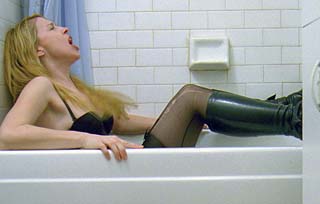
FH: Oh it is a horrible thing. I remember the guy who was sound mixing that scene, he couldn’t get past that scene and he got really mad at me. He said, you are not taking any stand on this, you are letting it go and are not saying it is good or bad. And I said, “that’s right.” I don’t need to. I’m not making a statement, it is the character. But for all the conservatives, she does believe in God.
Offscreen: God wants to fuck me, I think she says.
FH: Yes. And whose to say she is not right.
Offscreen: I think also, having spoken about Something Weird video and your love of the nudie picture, this film seems to be an homage to the nudie/porn flicks, like Deep Throat where the clit is in her throat, and in this film she has seven clitori….
FH: I never thought of it that way…
Offscreen: Like t scene where the kids are talking about John Holmes in the diner, to the point where it turns off the other customers and makes Batz feel queasy.
FH: I guess it is but I didn’t approach it that way. I would have liked the kids in that Holmes scene to be even younger, but I couldn’t cast it.
Offscreen: On the other hand you just turn the whole porn thing on its head. The film takes this character who watches so much porn, fantasizes about it, infinite orgasms and huge phalluses, and you seem to be saying, too much of a good thing….
FH: Yes. I also did that at the end of Frankenhooker: reducing people to body parts. Big dick, nice tits, huge ass. And I remember at the end of Frankenhooker, what you have are creatures that are big dicks and a huge ass, and nothing else!
Offscreen: Which takes us back to the gore gag thing, with Screaming Mad George the Special effects artist, and Brian Yuzna with these really bizarre, surreal body mutations, with the brain, the ear, etc., this amazing visual stuff.
FH: Yes I love that. I would love to do more, but it is expensive.
Offscreen: Not CGI.
FH: Well the stuff in Bad Biology is CGI on top of the prosthetics. Everybody thinks I did no CGI on my film but I did a lot of it.
Offscreen: Really.
FH: If you do it right. We just enhanced the special effects.
Offscreen: In terms of visual style and allusions. I spotted a reference to Peeping Tom. Was that just me reading into it? The fact that the Jennifer character is a photographer who photographs her lovers as they have orgasm and die.
FH: Oh yea, I didn’t even think of that.
Offscreen: Because you also have the flashback to her as a child, and we also have that in Peeping Tom, the flashback to the camera operator as a boy.
FH: Yes you are absolutely right. I wasn’t aware of that. That doesn’t mean I didn’t use it. I love Peeping Tom.
Offscreen: Osmosis.
FH: It just came out as a very practical matter. We thought, what does she do for a living and how does she meet the other guy. It just seemed like a logical choice if she is a photographer. Once we came up with that, it became obvious: what if she photographs the dead guys. And then it was, well what if we got a really good photographer to do these weird pictures.
Offscreen: I was going to ask you about those.
FH: He is a professional photographer, a guy called Clay Patrick McBride. What he specializes in is actually the opposite of what he did for us: celebrity photographs for magazines. He is always traveling all over the world doing very glossy, flat portraits of celebrities and I think that is why he enjoyed doing just the opposite.
Offscreen: Where they cut and paste or superimpositions?
FH: I’m not sure. He probably photoshopped and did this and that, but it was very surreal, how he shot them. We needed to get the pictures all at once, so one day we had a bunch of guys come over to my house all day long. Now I didn’t know half of these people. Some were friends of RA, some were people who were going to work on the film but who I didn’t know yet. They would walk in the apartment and Clay would look at them. He was moving so fast before they could object or think about it, he would say, “you take off your shirt, lie on the floor and give me an orgasm.” And that is how it was all day. And it was so surreal and creepy. At one point I answer the phone and see Clay filming someone in my bathtub! It was just weird. Worse than that, he is yelling at them and they are making these loud orgasm sounds and I have neighbors! All day long, with this parade of young men coming to my apartment and leaving twenty minutes later!
Offscreen: You’ll be the new celebrity on the block.
FH: Thank God Charlee came over that day to help out with some of the shots. We see her hand in some of the shots.
Offscreen: Getting back to visual style, I think the penis POV shots were shot with a wide angle and had a purple tint to them, is that right?
FH: Yes. We added purple to it. That wide angle was actually CGI. We added that effect to make it appear even wider than it was. We had rented some lens and it just didn’t work. We just stuck on an 18mm lens and ran with the camera across the floor.
Offscreen: The 18mm, that was one of Orson Welles’ favorite lenses. He used it for A Touch of Evil!
FH: The trouble with that is when you are shooting on location you have to be sure you are not getting cables and stuff like that in the frame. We worked so fast that some of that stuff got in and we had to use CGI to paint it out. There is a scene where the camera pans over and you see a plug with 17 cords going into it. Not anymore, we painted it out!
Offscreen: It has been a while since I’ve seen some of your early films but there are a couple of scenes in Bad Biology, especially in the addiction scene and when we the characters first meet and talk, where the camera is fairly static and the shot is held for a very long time, 2,3, 4 minutes. Is this something new to you?
FH: I have always liked that. I really did that a lot in Basket Case. Remember I was saying that I like Otto Preminger [an off-interview comment]. That’s where it is. My favorite shot I’ve ever done was in Basket Case. A dialogue scene with Dwayne where we did 17 dolly moves while he was talking. I spend all morning rehearsing and shooting but when we were done we had two and a half pages of script in the can. So I do like that. I wish I could have done more of that in Bad Biology but I didn’t have the time or equipment to do the kind of elaborate dolly shots I would have liked. You sort of know that going in so you balance it out by doing it other ways, so you don’t really miss it.
Offscreen: Because you had a young DP, Nick Deeg.
FH: Yes this was his first film. He had done a music video with us and we liked him. I knew we could trust him. He had a passion for lighting which is more important than anything. And he has no ego. He didn’t fight me. I camera operated. I camera operated my first two movies, Basket Case and Brain Damage. And then on Basket Case 2 I had a great DP so I did not have to do it. On Frankenhooker I shot about half of it. And on Basket Case 3 I had another good DP so I didn’t need to camera operate. But I like it. So as good as Nick was I told him I really want to get back to camera operating and he was fine with that. He did all the difficult shots, the running around with the 35mm camera. Any hand-held camera with the 35mm, that is a heavy camera. Heck I’m an old man, let the 26 year old do it. There was no ego with Nick and his lighting was wonderful. When I would suggest something he would say and then make it better.
Offscreen: Did you have video assistance to see what you were shooting?
FH: Well there is a video tap on the camera, and that is often very misleading because it looks so different. It is only meant as a reference guide. Like the shot where Anthony comes in with the hooker and they walk in and the camera is up at the stairs looking down at them. As they start to walk up the camera rises up to the second floor and sees the girl on the bed. We were filming at a mansion. We got to the top of the stairs but there was no place for the camera operator to be. Basically I’m off to the side with the video tap, trying to rehearse the shot on the video tap. That is what it is for. It is not ideal. The scene where Anthony is in the bathroom and he is fighting with something below the frame, there was only three other crew members in that scene, all in the bathtub, there was no room.
Offscreen: Especially with a guy with a huge member like that! Once Batz’s penis is dislodged from his body, it seems like you made it intentionally unreal and ugly.
FH: Oh yes, well if you think about it, it has been shot with growth hormones and steroids so the veins would be excessive.
Offscreen: That’s true I did not think of that.
FH: And also, I did not want some friendly looking thing. It is not a fun thing.
Offscreen: It is almost like a cobra snake.
FH: Yes well we did that deliberately. In fact Gabe Bartalos, who had worked with Matthew Barney on some of the Cremaster videos, and he did a lion or tiger woman with an elaborate tail. So, to save money, he asked me, what do you think about this tail for the penis. I said, Dave that is fine with me, but it looks like a cobra, which he thought was a bad thing but I said, no, let’s use that. I is kind of creepy. And it actually works like a cobra. You kind of forget what it is the way it is moves back and forth. I thought, lets play with that.
Offscreen: We can maybe end with an cute observation. The great American director John Ford at I believe a director’s guild meeting stood up and said, “My name is Jack Ford and I make westerns.” Very non-pretentious. I was looking at your list of films, Basket Case, Brain Damage, Basket Case 2, Frankenhooker, Basket Case 3: The Progeny, and Bad Biology and I thought, you know if you would change the title of Frankenhooker to something like “Brainenhooker” you could stand up and say, “my name is Frank Henenlotter and I make ‘B’ movies!”
FH: (Laughs) I know, I know. I actually would rephrase it because I don’t think they are B-movies. I think they are good old exploitation movies. And I am proud of that.
Offscreen: And you should be.
There is nothing wrong with that.
Offscreen: Well, I’m so happy that we did this. I really enjoyed it. Thanks.




